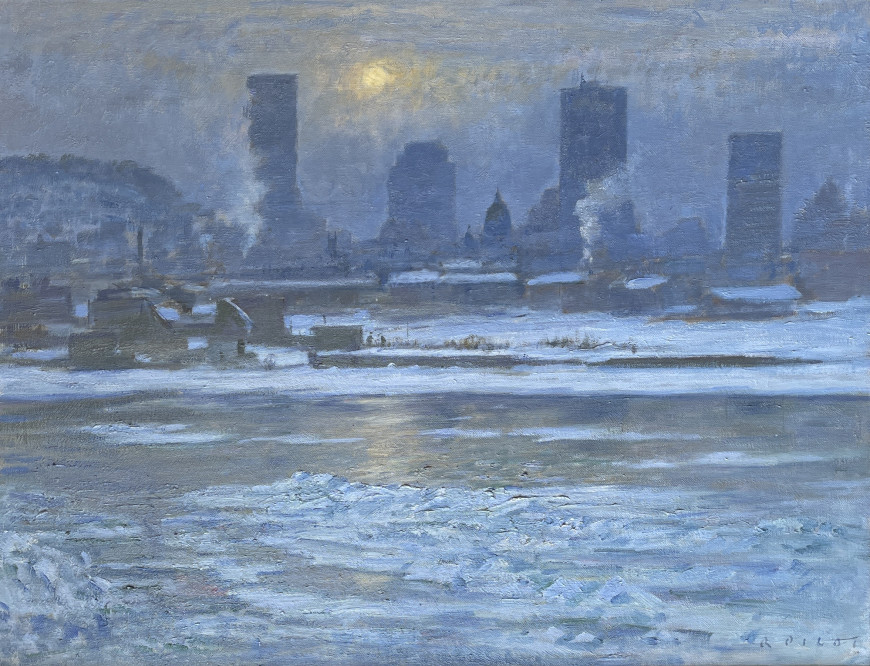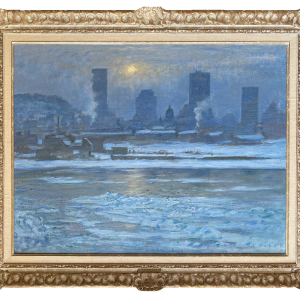-
Artworks
Robert PilotSpring Ice, from Saint Helen's Island, 19651897-1967Oil on canvas28 x 36 in
71.1 x 91.4 cmSoldInscriptions
signed, ‘R PILOT’ (lower right); titled signed and dated, ‘SPRING ICE - MONTREAL from St. Helen’s Is. MONTREAL/R. Pilot - 1965’ written over ‘W-PILOT 65’ (verso, upper horizontal stretcher)Provenance
Walter Klinkhoff Gallery Inc., Montreal;
Acquired from the above by the present owner.
"Spring Ice, from Saint Helen’s Island" is an achievement of the finest quality of work Pilot generally reserved for the views looking from the south shore at Levis toward Quebec City. Robert Pilot collectors and students of his career will marvel at the confidence of hand the master demonstrates in this 1965 composition. Blair Laing, who exhibited Robert Pilot’s works from 1948 commented on Pilot as being “an important artist” and one who was “at his best one of Canada’s finest artists [1].”
Footnote
1. Blair G. Laing, “Memoirs of an Art Dealer”, Vol. 2 (Toronto: McClelland and Stewart, 1979) p. 146
__________
Robert Wakeham Pilot (1898-1967)
“The painter’s work is not very complicated. A palette, paintbrushes, and tubes of colour. With that, when we have something to express, we strive to say it as best we can” — (Robert W. Pilot to Jean Chauvin, 1928)
Qualified as the “last Canadian impressionist” Robert. W. Pilot’s career and œuvre are well-known.
A native of Saint John’s, Newfoundland, born in 1898, Robert W. Pilot, a precocious artist, first began studying at his stepfather’s studio and later attended Edmond Dyonnet’s evening classes in Montreal. His first solo exhibition, held at the Johnson Gallery, in 1915—at barely 20 years old!—garnered him some success. Pilot pursued his artistic training (1915–1916, 1918–1920) at the Art Association of Montreal art school, then under the tutelage of Cullen and William Brymner. He enlisted in the army during both world wars (1917–1918, 1941–1944). Upon his return to Montreal in 1919, he obtained a scholarship from the AAM. Nonetheless, it is in Paris that the young artist would perfect his craft for over two years (1920–1922), studying at the Académie Julian under Jean-Paul Laurens, one of the most popular professors among the Canadian students. As a member of the Société nationale des beaux-arts, Pilot also exhibited in the 1922 Salon and travelled, among other places, to Brittany. As a painter, printmaker and a muralist, Robert W. Pilot, a landscape artist above all else, garnered recognition from the public and critics alike, as of the 1920s. He regularly participated in the AAM Spring Exhibitions (1914–1967) and the Royal Canadian Academy of Arts annual exhibitions (RCAA, 1913–1966). In 1920, Pilot was one of the few artists invited to the Group of Seven inaugural exhibition held at the Art Gallery of Toronto. Over the following two years, Pilot was featured in the Beaver Hall Group annual presentation, in Montreal. He also travelled and painted in Europe and North Africa on multiple occasions. From 1935 to 1940, Pilot taught printmaking at the École des beaux-arts in Montreal. He was represented by Watson Art Galleries as of 1923 and by the Continental Gallery and Galerie Walter Klinkhoff in the 1950s and 1960s. Pilot’s work was presented in many solo exhibitions which were commercially successful. As a member of several artistic associations, the painter received many awards and accolades, notably the Jessie Dow award from the AAM, twice (in 1932 and in 1934) as well as the Coronation Medal (1953) awarded by the Canadian government. Following his death in Montreal, in 1967, after a career spanning over 50 years, three retrospectives are finally dedicated to his work: at the Kitchener-Waterloo Art Gallery (1967) The Montreal Museum of Fine Arts (1968, later presented at the National Gallery of Canada and at the Art Gallery of Hamilton, in 1969), as well as at Galerie Walter Klinkhoff (1988). Today, Pilot’s work is present in most Canadian art museum collections, as well as in numerous clubs, corporations and other private collections.
Perpetuating the Impressionist tradition initiated by Morrice, Suzor-Coté and Cullen, Pilot, a solitary and discreet artist, shunned the modern art and movements of his time to focus instead on the endurance of a Québécois or maritime culture, ancestral and traditional. Beyond Quebec, his beloved city, the prolific painter wandered, much like a Clarence Gagnon, across the diverse picturesque territories of the province, particularly along the Saint-Lawrence River, not to mention the Atlantic provinces where he comes from.
With thanks to Nathalie Thibault, curator of the archives and manager of documentation and digital distribution of the collections at the Musée National des beaux-arts du Québec.
Mario Béland, Ph.D., MSRC











